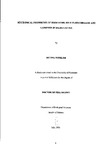Mechanical properties of hoof horn, sole haemorrhage and lameness in dairy cattle
| dc.contributor.author | Winkler, Betina | |
| dc.contributor.other | Faculty of Science and Engineering | en_US |
| dc.date.accessioned | 2013-10-21T08:57:11Z | |
| dc.date.available | 2013-10-21T08:57:11Z | |
| dc.date.issued | 2005 | |
| dc.identifier | NOT AVAILABLE | en_US |
| dc.identifier.uri | http://hdl.handle.net/10026.1/2233 | |
| dc.description | Merged with duplicate record 10026.1/859 on 27.03.2017 by CS (TIS) | |
| dc.description.abstract |
The present study aimed to develop a method to measure changes in the mechanical properties of the sole and white line hoof horn that should be used in vivo and to examine the hypothesis that the presence of haemorrhages in the horn would represent a weakening of the structural strength of the horn. Hoof horn samples were collected from the sole and white line areas of the hoof horn of dairy cattle. The maximum punch force, work to fracture, elastic modulus and membrane stress were measured through the use of a punch test and the elastic modulus was measured through the use of a tension test. The elastic modulus of the diaphragm, membrane stress and elastic modulus measured through tension test of the sole and white line areas were found to increase significantly and exponentially (P<0.01, R²adj. = 0.39 to 0.81) and the punch force and work to fracture increased significantly and linearly (P<0.01, R²adj. = 0.37 to 0.89) in relation to the dry matter content of the hoof horn. Sample thickness accounted for 30 to 40 % of the variation of the punch force and work to fracture results, therefore the thickness of the tested area was measured and included as a covariant in the statistical analysis of those tests. Punch force of the sole area of the claw horn decreased significantly (P<0.001) (8.72, 8.53, 8.06, 7.75, 6.08, 4.99 N, sem 0.078 to 0.460) when haemorrhage levels of the tested area increased (0 to 5). In multiparous cows that had higher scores for lesions of the claw horn when compared to the heifers the punch force decreased at day 160 postpartum when the cows had greater lesion scores and was lower in hind claws that had higher lesion scores when compared to the front claws. Lower punch force and elastic modulus were found in heifers with less straight rear legs, lower foot angle, poor HUKI locomotion score, lower scores for the composite trait legs and feet and a higher HUKI final total score. The measurement of the mechanical properties of the hoof horn has contributed to the understanding of the changes occurring during the peripartum period that predispose dairy cows to acquire horn lesions and suffer from lameness and has proven to be a good method for measuring the influence of housing systems and cow conformation on the strength and elasticity of the horn. | en_US |
| dc.language.iso | en | en_US |
| dc.publisher | University of Plymouth | en_US |
| dc.title | Mechanical properties of hoof horn, sole haemorrhage and lameness in dairy cattle | en_US |
| dc.type | Thesis | |
| dc.identifier.doi | http://dx.doi.org/10.24382/3840 |
Files in this item
This item appears in the following Collection(s)
-
01 Research Theses Main Collection
Research Theses Main


